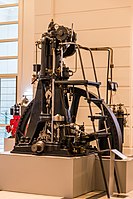
Photo from wikipedia
Comprehensive two dimensional GC has been utilized for analyzing complex mixtures of hydrocarbons of diesel feeds. Here, we evaluated 19 diesel feeds for their Paraffinic, Naphthenic and Aromatic group compositions… Click to show full abstract
Comprehensive two dimensional GC has been utilized for analyzing complex mixtures of hydrocarbons of diesel feeds. Here, we evaluated 19 diesel feeds for their Paraffinic, Naphthenic and Aromatic group compositions dictating their flammability properties. Compositional ranges of feeds were as follows; Paraffins: 9.6-57.8%, Naphthenes: 7.9 - 38.5% & Aromatics: 10.5 - 82.3%. Diesel's flammability performance is estimated by thermodynamic conditions and rates of radical formation of hydrocarbon type in actual engine condition, limiting Cetane Number. However, limitations are overcome by understanding the relative compositional variations of feeds by simple ranking of feeds based on C15-16 compositions. Due to multidimensional variability of feeds, a principal component analysis was adopted later for its distinguishing capability. Paraffinic, Naphthenic and Aromatic group's principal component analysis clustered up feeds based on the higher concentration of individual hydrocarbon group. We explored Hierarchical cluster analysis to organize feeds into classes of mixed C9 to C26 paraffin's composition in the diesel range. Further, for discriminating C15-C16 enriched and depleted feeds in total paraffins composition, a row dendrogram with heat map was drawn. Above multivariate methods have led to a fair distinction of non-additive feed compositions influencing flammability properties by radical formation rate. This article is protected by copyright. All rights reserved.
Journal Title: Journal of separation science
Year Published: 2021
Link to full text (if available)
Share on Social Media: Sign Up to like & get
recommendations!